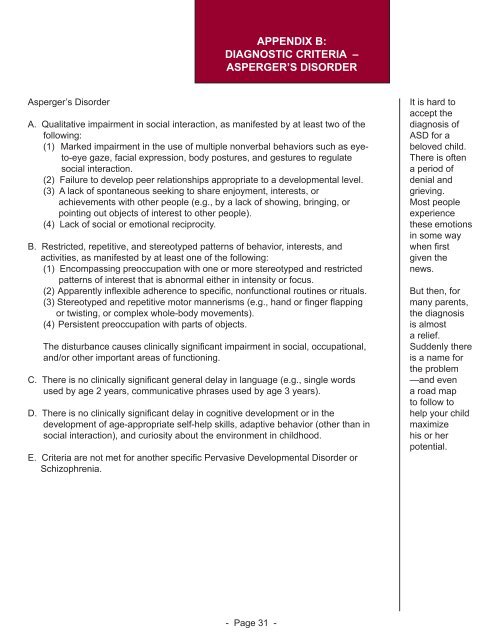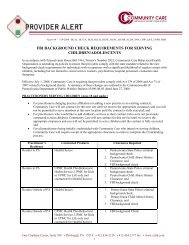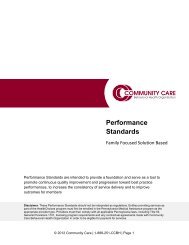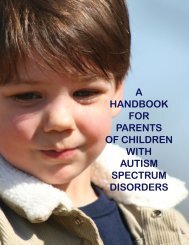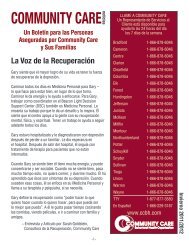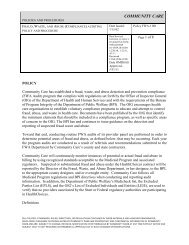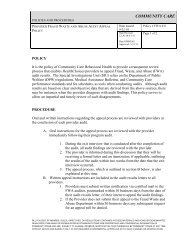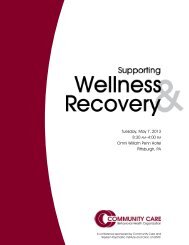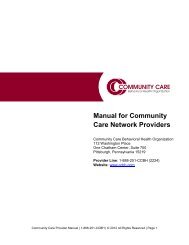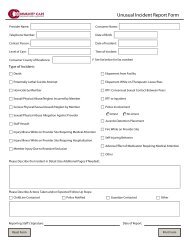a handbook for parents of children with autism spectrum disorders
a handbook for parents of children with autism spectrum disorders
a handbook for parents of children with autism spectrum disorders
- No tags were found...
You also want an ePaper? Increase the reach of your titles
YUMPU automatically turns print PDFs into web optimized ePapers that Google loves.
APPENDIX B:DIAGNOSTIC CRITERIA –ASPERGER’S DISORDERAsperger’s DisorderA. Qualitative impairment in social interaction, as manifested by at least two <strong>of</strong> thefollowing:(1) Marked impairment in the use <strong>of</strong> multiple nonverbal behaviors such as eyeto-eyegaze, facial expression, body postures, and gestures to regulatesocial interaction.(2) Failure to develop peer relationships appropriate to a developmental level.(3) A lack <strong>of</strong> spontaneous seeking to share enjoyment, interests, orachievements <strong>with</strong> other people (e.g., by a lack <strong>of</strong> showing, bringing, orpointing out objects <strong>of</strong> interest to other people).(4) Lack <strong>of</strong> social or emotional reciprocity.B. Restricted, repetitive, and stereotyped patterns <strong>of</strong> behavior, interests, andactivities, as manifested by at least one <strong>of</strong> the following:(1) Encompassing preoccupation <strong>with</strong> one or more stereotyped and restrictedpatterns <strong>of</strong> interest that is abnormal either in intensity or focus.(2) Apparently inflexible adherence to specific, nonfunctional routines or rituals.(3) Stereotyped and repetitive motor mannerisms (e.g., hand or finger flappingor twisting, or complex whole-body movements).(4) Persistent preoccupation <strong>with</strong> parts <strong>of</strong> objects.The disturbance causes clinically significant impairment in social, occupational,and/or other important areas <strong>of</strong> functioning.C. There is no clinically significant general delay in language (e.g., single wordsused by age 2 years, communicative phrases used by age 3 years).D. There is no clinically significant delay in cognitive development or in thedevelopment <strong>of</strong> age-appropriate self-help skills, adaptive behavior (other than insocial interaction), and curiosity about the environment in childhood.E. Criteria are not met <strong>for</strong> another specific Pervasive Developmental Disorder orSchizophrenia.It is hard toaccept thediagnosis <strong>of</strong>ASD <strong>for</strong> abeloved child.There is <strong>of</strong>tena period <strong>of</strong>denial andgrieving.Most peopleexperiencethese emotionsin some waywhen firstgiven thenews.But then, <strong>for</strong>many <strong>parents</strong>,the diagnosisis almosta relief.Suddenly thereis a name <strong>for</strong>the problem—and evena road mapto follow tohelp your childmaximizehis or herpotential.- Page 31 -


